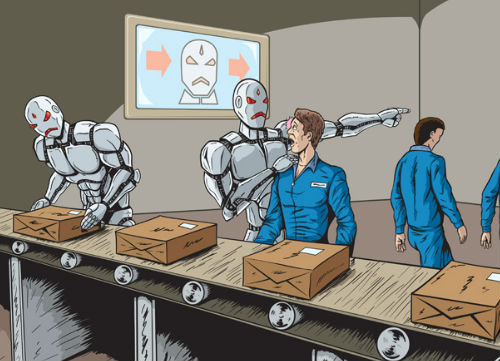Over time the relationship between innovation and employment many people have not seen with good eyes. Years ago, innovation was seen as a potential threat to employment, where economists have criticized it in an adverse sense as a generator of employment. The argument is that technological change can create unemployment through the substitution of labor for capital.
The discussion has evolved since then, taking into account that different types of innovation in different market conditions can generate different effects on the level and composition of employment.
For example, process innovation can induce a substitution of capital for work, but it can also lead to higher productivity, lower prices and higher demand, which in the long run can create new jobs for displaced workers ( the known effects of compensation).
In this way, the final effects of innovation in terms of employment depend on the balance between substitution and compensation effects. Next, I recommend a couple of articles where the well-known economist Larry Summers writes in The Economist ("Coming to an office near you" and "The wavering wave") where the debate about the concern that employees should have about the new technologies that bid to replace them.

Although they recognize that in the long term innovation still seems beneficial both in terms of quantity and quality of jobs, economists believe that technological change is increasingly taking the form of "capital that effectively replaces labor" and that we could be against a temporary phase of mismatch after productivity gains induced by the recent and rapid series of technological changes.
This is and always will be an exciting discussion about the future of work versus innovation, and this due to the irruption of technologies. In this sense, the debate opens with a simple question: does innovation create or destroy jobs? It is difficult to answer the question in the long term, just because they are going to produce things that, by their level of disruption, now we can not even imagine, as we could not imagine what Google was going to be in 1990.
Is innovation a threat to employment in Latin America?
This question has important consequences for public policy makers in these countries. Most of the policies designed to promote innovation and the adoption of new technologies in Latin America have been applied under the assumption that they contribute to economic growth in general and to the creation of employment in particular.
Although rarely questioned, this approach is based on the premise that technological change not only leads to greater efficiency, but also, over time, to the creation of new and better jobs.
According to a series of studies conducted by the IDB, the answer to this question is NO, with some caveats. In Argentina, Chile, Costa Rica and Uruguay it relates the growth of employment with innovation of products and processes. The results clearly show that compensation effects prevail, so the introduction of new products generates employment growth at the company level. At the same time, process innovation would have a negative effect on employment only in the case of Chile.
Another IDB study goes further, analyzing the impact of different business innovation strategies. In this paper we find that the technological changes resulting from activities developed within the company are much more pro-employment than those resulting from the adoption of technologies developed outside the company.
Finally, the effect of innovation policies on employment is also directly addressed in the impact evaluations of programs aimed at promoting innovation. On the other hand; it was possible to analyze separately the effects of the subsidies destined to promote the innovation of processes and products. The results show that both support for process and product innovation have contributed to the creation of new and better jobs (that is, better paid jobs), but they also confirm that support for product innovation has the highest profitability in terms of the quality of the jobs created.

So? What we are seeing is that innovative ecosystems have significantly lower unemployment rates than non-innovative areas. And, in my opinion, there is a dynamic that redistributes talent, technology and work; and it concentrates them again in innovation zones (Hubs), in a positive feedback effect.
As we have seen in Latin American countries, there are governments willing to invest in innovation. With the creation of Hubs or innovative ecosystems, there is a dynamic of attracting talent: the best scientific, technological or entrepreneurial talent from non-innovative areas migrates to innovative areas, where they find more opportunities and better salaries. In these innovative areas, the technologies of the future are developed, which are exported to non-innovative areas (where they are deployed in the form of production chain automation, and generate more unemployment). The innovative areas are focused on R & D and design activities, but in a digitalized industry environment that is increasingly independent of location and scale, also the most sophisticated manufacturing activities are attracted to innovative areas, since the proximity to knowledge centers accelerates their product development cycles and allows them to compete globally in innovation. Innovative areas concentrate advanced manufacturing, leaving the less sophisticated and dependent on labor costs in non-innovative areas, which become precarious. Innovative areas generate higher business margins, healthier taxation, and stronger welfare states. The flows of talent, technology, work, and investment capital flow towards innovative ecosystems; while draining the same from non-innovative areas. It suffices, to contrast this hypothesis, to compare the regional maps of innovation, and of unemployment in the countries of Latin America. The correlation is very accurate, I would say: the higher the innovative index, the lower the unemployment.
In conclusion, studies indicate that innovation and employment are correlated ... at least for now ... So, governments must urgently invest in smart innovation policies if they want to create jobs and sustain social welfare. Even I am of the criterion that in the long term, only the innovative zones will be able to be allowed to maintain formulas of public sustenance of educative, sanitary or social systems of quality.
WOULD YOU LIKE TO COMMENT POST?
